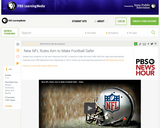
Informational text piece discussing how new NFL rules are making football safer. Student handout and video. High interest.
- Subject:
- English Language Arts
- Material Type:
- Reading
- Student Guide
- Provider:
- PBS LearningMedia
- Date Added:
- 11/03/2017

Informational text piece discussing how new NFL rules are making football safer. Student handout and video. High interest.
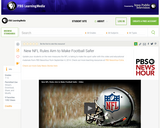
The NFL kicked off its new season last night with new safety measures that may lessen the chance of injury for players. Video, teacher page, and student handout included.
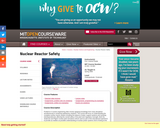
" Problems in nuclear engineering often involve applying knowledge from many disciplines simultaneously in achieving satisfactory solutions. The course will focus on understanding the complete nuclear reactor system including the balance of plant, support systems and resulting interdependencies affecting the overall safety of the plant and regulatory oversight. Both the Seabrook and Pilgrim nuclear plant simulators will be used as part of the educational experience to provide as realistic as possible understanding of nuclear power systems short of being at the reactor."

Students design and build prototypes for protective eyewear. They choose different activities or sports that require protective eyewear and design a device for that particular use. Students learn about the many ways in which the eyes can be damaged and how engineers incorporate different features and materials into eyewear designs to best protect the eyes.
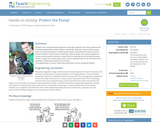
Students learn how biomedical engineers work with engineers and other professionals to develop dependable medical devices. Specifically, they learn about suction pumps, which are important devices to keep in good repair, especially when they are used in remote locations. Student teams brainstorm, sketch, design and create prototypes of suction pump protection devices to keep fluid from backing up and ruining the pump motors. Using a real suction pump, they conduct repeated trials to test their devices for reliability, making improvements as necessary.
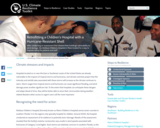
After conducting an assessment that showed their buildings vulnerability to wind damage, the Nicklaus Childrens Hospital in Miami looked for a way to improve safety for patients and staff.
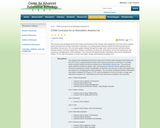
This resource was developed by the Kent Career and Technical Center through seed funding from the CAAT and is a project-based curriculum that revolves around the construction of a working electric powered vehicle that will be entered into an Electrathon America race. This curriculum guides students through the design, build, and test process with their electric powered vehicle. Curriculum experiences include a combination of classroom, lab learning, on-site work experiences, and exposure to emerging green career pathways. The curriculum developed includes mathematics and science standards for Physics, P1-P4, with an emphasis on forces and motion, energy, and electricity for grades 9-12.

This website is great for teaching students to recognize signs, symbols, and labels related to safety. The website provides pictures and descriptions of physical safety symbols, fire safety symbols, first-aid symbols, hazard symbols, radiation hazard symbols, and other symbols. As an interactive activity, students should make flashcards as they navigate the website. The front side of the flashcard could have a picture or drawing of the symbol, and the backside could have a description of its meaning. The goal of this activity is to familiarize students with safety symbols, labels, and signs that they may encounter in a medical setting, so they can recognize them and stay safe in their future healthcare jobs. As a supplemental activity, students could use the scenario worksheet linked in the WISELearn description (answer key provided). Students could also complete a scavenger hunt around the school's science laboratories to find safety symbols. If a science lab is not available, then teachers could print pictures of medical settings, and students can identify all the signs, symbols, and labels in the pictures. Another supplemental activity could be doing the flyswatter review game; pictures of the signs, symbols, and labels would be printed and taped to the board. Teachers would read descriptions to two students with flyswatters, and they race to identify the correct symbol.
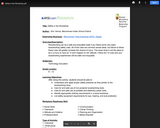
Woodworking can be a safe and enjoyable trade if you follow some very basic woodworking safety rules. All of the rules are common-sense ideas, but failure to follow these rules will greatly increase the chance of injury. The wood shop is not the place to be in a hurry or have an "it won't happen to me" attitude. Follow the 10 rules and your woodworking experiences will be safer and enjoyable.
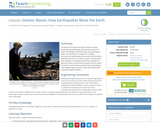
Students learn about the types of seismic waves produced by earthquakes and how they move the Earth. The dangers of earthquakes are presented as well as the necessity for engineers to design structures for earthquake-prone areas that are able to withstand the forces of seismic waves. Students learn how engineers build shake tables that simulate the ground motions of the Earth caused by seismic waves in order to test the seismic performance of buildings.
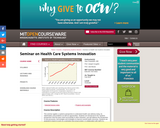
This seminar applies a systems perspective to understand health care delivery today, its stakeholders and problems as well as opportunities. Students are introduced to the 'systems perspective' that has been used successfully in other industries, and will address the introduction of new processes, technologies and strategies to improve overall health outcomes. Students are assigned to teams to work on a semester_long group project, in collaboration with staff of a nearby Boston hospital.

Students learn about how engineers design and build shake tables to test the ability of buildings to withstand the various types of seismic waves generated by earthquakes. Just like engineers, students design and build shake tables to test their own model buildings made of toothpicks and mini marshmallows. Once students are satisfied with the performance of their buildings, they put them through a one-minute simulated earthquake challenge.
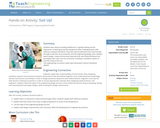
Students learn about providing healthcare in a global setting and the importance of wearing protective equipment when treating patients with infectious diseases like Ebola. They learn about biohazard suits, heat transfer through conduction and convection and the engineering design cycle. Student teams design, create and test (and improve) their own Ebola biohazard suit prototypes that cover one arm and hand, including a ventilation system to cool the inside of the suit.
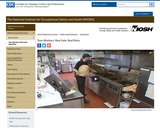
This video from the National Institute for Occupational Safety and Health focuses on real teens in the workplace in regard to health and safety. It goes over employer/employee rights and responsibilities and discusses some ways to keep workplaces safe in various situations.